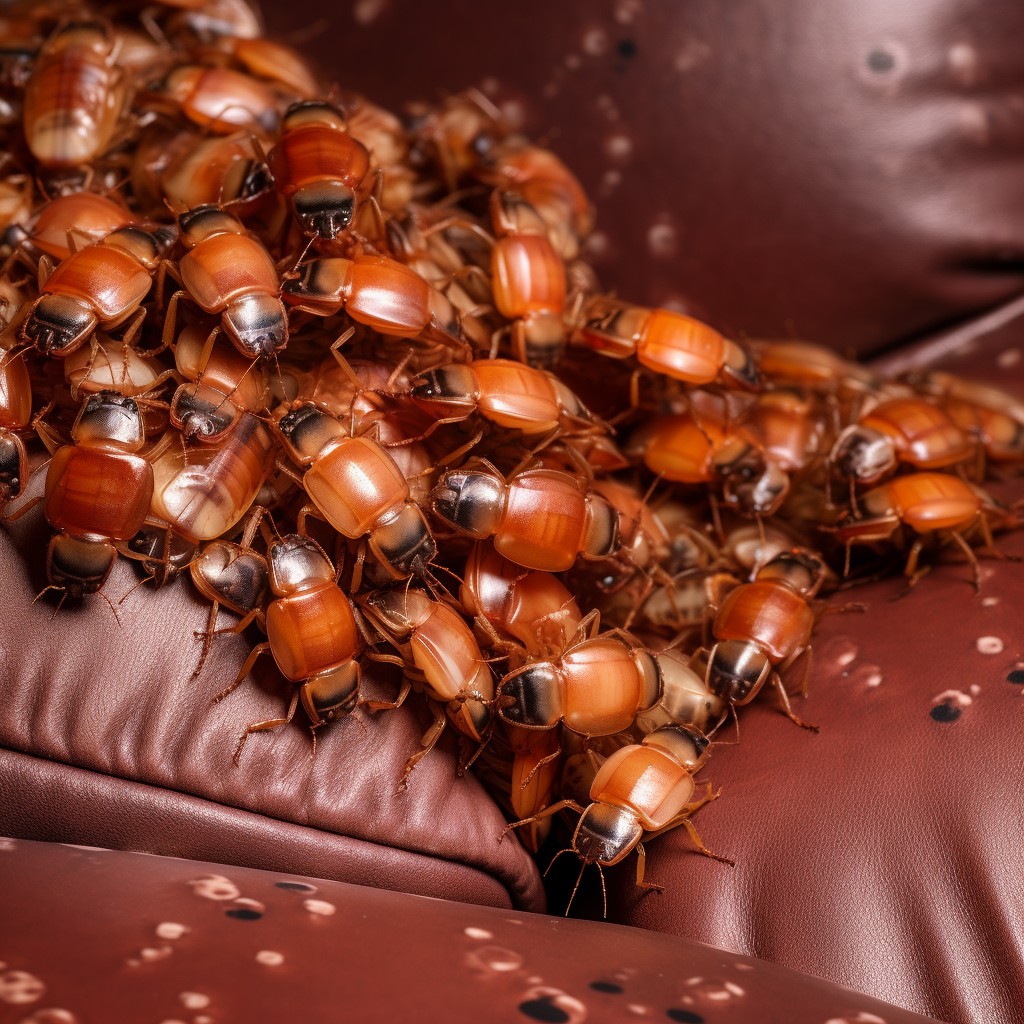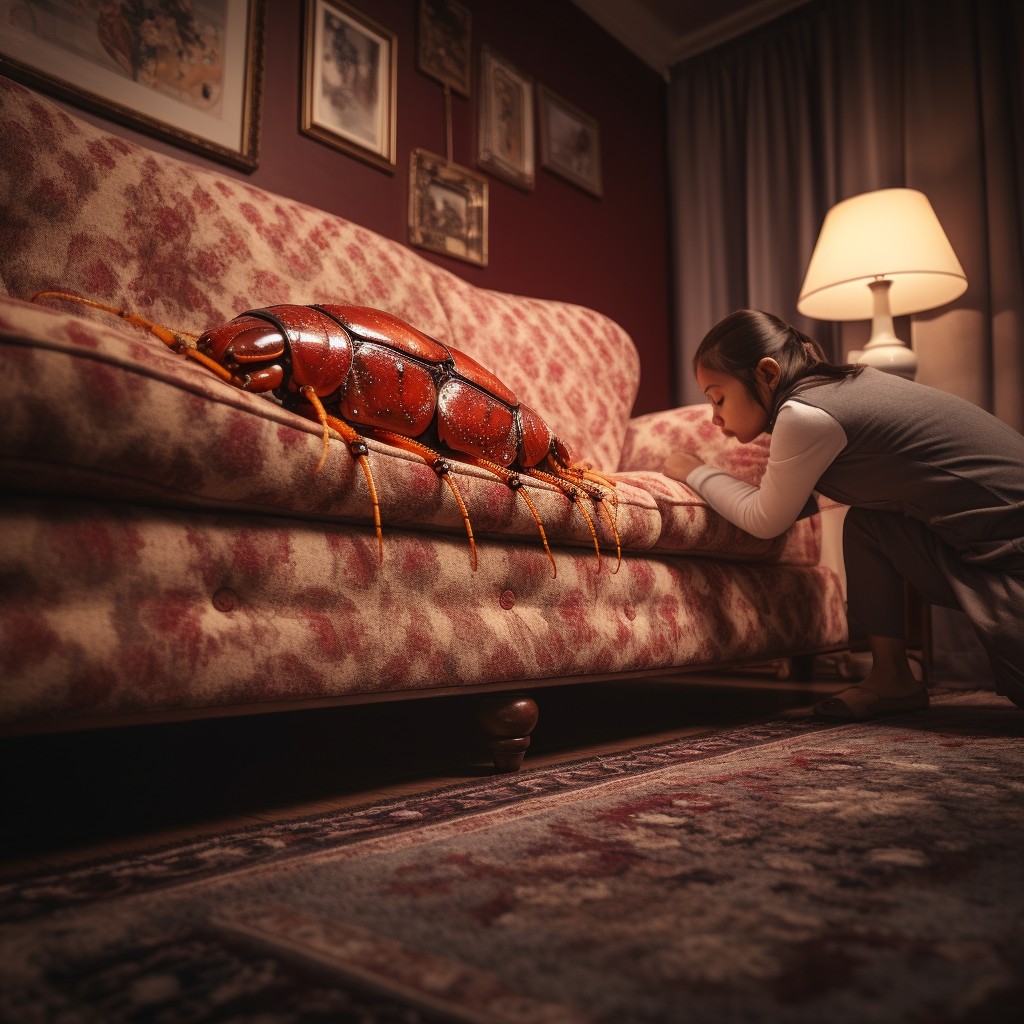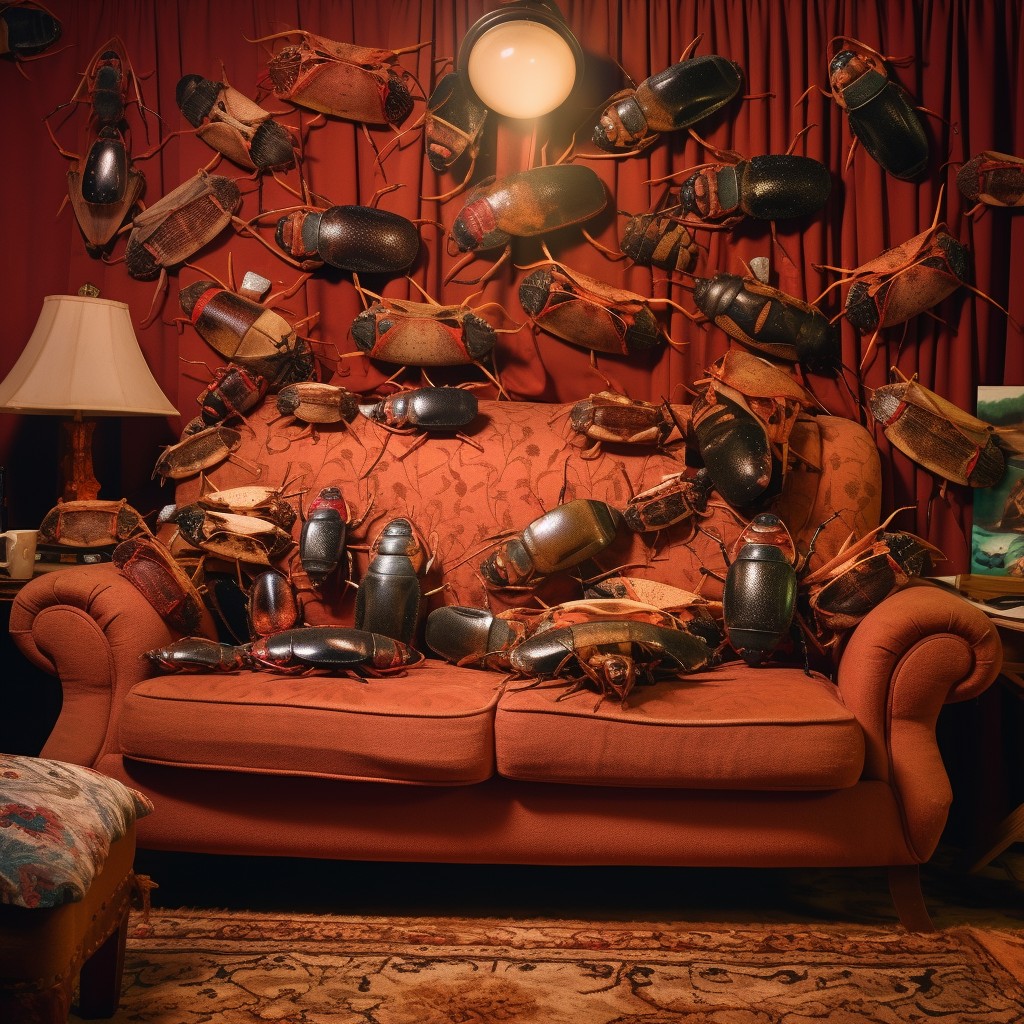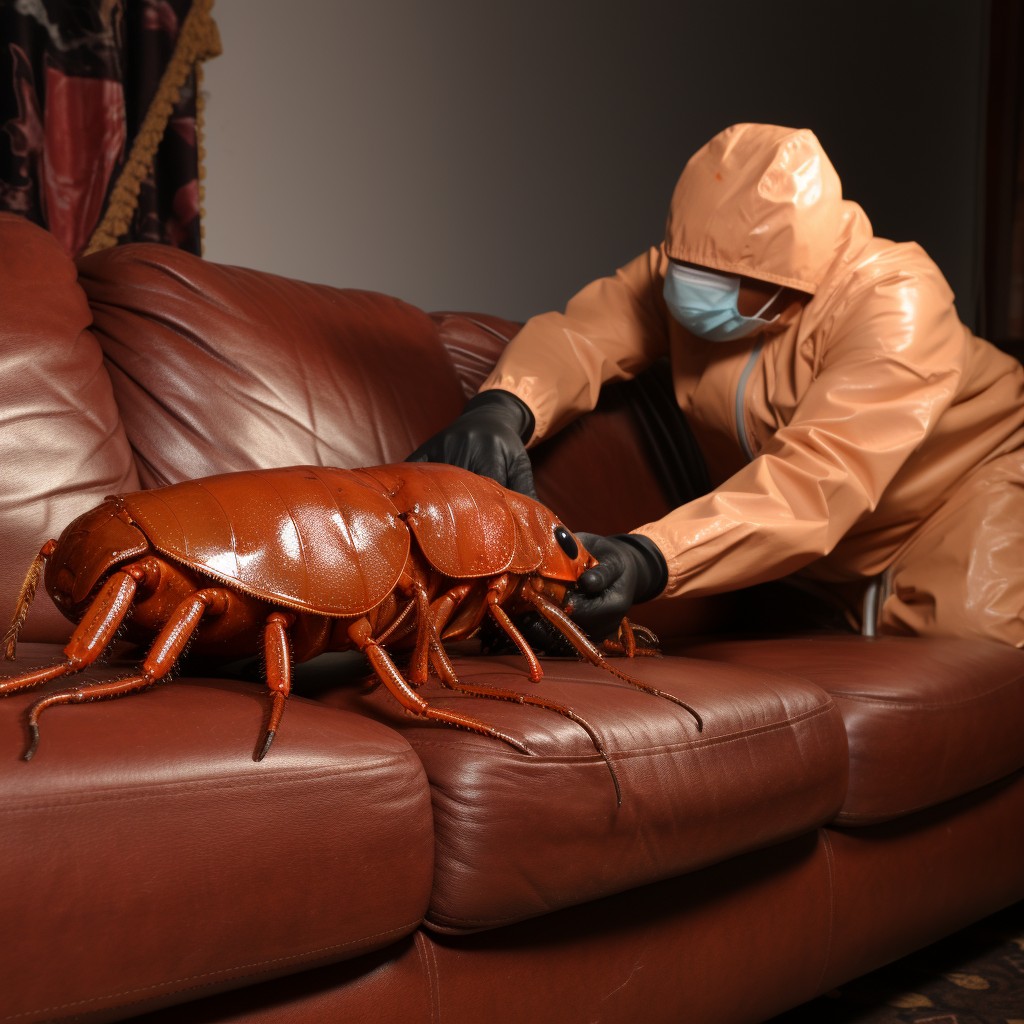Last updated on
Discover the effective methods to eliminate bed bugs from your couch and reclaim a bug-free relaxing space in your home.
Bed bugs are one of the most annoying pests that can invade your home. These tiny insects can hide in your couch and other furniture, making it difficult to get rid of them.
If you have been struggling with a bed bug infestation in your couch, don’t worry! In this article, we will provide you with effective tips on how to kill bed bugs in couch. By following these methods, you can say goodbye to these pesky insects once and for all! So let’s dive into the details and learn how to eradicate bed bugs from your beloved couch.
Table of Contents
Identifying Bed Bugs

The first step in getting rid of bed bugs from your couch is to identify them. Bed bugs are small, reddish-brown insects that feed on human blood.
They are about the size of an apple seed and can be found hiding in cracks and crevices around your home.
To identify bed bugs, look for tiny black or brown spots on your couch or other furniture. These spots may be fecal matter left behind by the insects after feeding on blood.
You may also notice shed skins or eggshells near infested areas.
Another way to spot bed bugs is by their bites which appear as red welts with a darker center usually arranged in a line pattern.
If you suspect that you have a bed bug infestation, it’s important to act quickly before they spread further throughout your home.
Inspecting the Couch

Inspecting your couch is crucial as it helps you determine the extent of infestation and identify areas where bed bugs are hiding. Start by removing all cushions and pillows from the couch and placing them on a white sheet or towel.
Next, use a flashlight to examine every inch of your sofa carefully. Pay close attention to seams, crevices, folds, buttons or zippers as these are common hiding spots for bed bugs.
Look for any signs such as eggs shells or fecal stains that indicate an active infestation.
Signs of a Bedbug Infestation

Here are some signs to look out for:
1. Bloodstains: If you notice small bloodstains on your couch or bedding, this could be a sign that bed bugs have been feeding.
2. Fecal Spots: Bed bugs leave behind dark fecal spots on surfaces where they hide and feed.
3. Shed Skins: As bed bugs grow and mature, they shed their skins which can accumulate in the areas where they hide.
4. Live Bugs: The most obvious sign of an infestation is seeing live bedbugs crawling around on your furniture or bedding.
How to Check for Bed Bugs in a Leather Couch

There are some ways to check for bed bugs in your leather couch.
Firstly, use a flashlight and inspect the entire surface of your couch thoroughly. Look for any signs of small reddish-brown insects or tiny white eggs that may be present on the surface or hidden within cracks and crevices.
Next, remove all cushions from your leather sofa and examine them carefully. Check along seams as well as under buttons if applicable.
Bedbugs often leave behind dark spots (fecal matter) which is an indication of their presence.
You can also use sticky tape around areas where you suspect bed bug activity; this will help trap any crawling insects so that they cannot escape detection easily.
Vacuuming the Couch
Start by removing all cushions and pillows from your couch, then use a crevice tool attachment to clean every nook and cranny. Pay special attention to seams, folds, and tufts where bed bugs like to hide.
After vacuuming the surface of your couch, make sure you dispose of the vacuum bag or empty its contents into a sealed plastic bag immediately. This will prevent any surviving bed bugs from escaping back into your home.
Vacuuming should be done regularly as part of an ongoing maintenance routine for preventing future infestations. It’s also important that you inspect other furniture items in close proximity such as chairs or ottomans since they can serve as hiding spots for these pests too.
Using Steam Cleaners
The high temperature of the steam can penetrate deep into the fabric and kill bed bugs at all stages of their life cycle, including eggs, nymphs, and adults. To use a steam cleaner on your couch:
- Start by vacuuming the entire surface to remove any loose debris.
- Fill up your steam cleaner with water according to its instructions.
- Turn on the machine and wait for it to heat up.
- Slowly move the nozzle over every inch of your couch’s surface while pressing down on its trigger button.
Make sure you cover every nook and cranny where bed bugs might be hiding such as seams, folds or tufts in cushions.
It’s important that you hold each section long enough (about 30 seconds) so that it reaches a temperature between 160-180°F which is lethal for Bed Bugs.
After steaming one area move onto another until you have covered all areas thoroughly then let dry completely before using again or covering with encasements if necessary.
Applying Diatomaceous Earth
It works by dehydrating the insects, causing them to die within a few days of contact with the powder. To apply diatomaceous earth on your couch, start by vacuuming it thoroughly to remove any visible bed bugs or eggs.
Next, sprinkle a thin layer of diatomaceous earth over the entire surface of your couch and use a brush or broom to spread it evenly. Be sure not to leave any gaps as this will allow bed bugs an escape route.
Leave the powder on for at least 24 hours before vacuuming again using high suction power. Repeat this process several times until you are confident that all bed bugs have been eliminated from your couch.
Chemical Treatment
There are various types of insecticides available on the market that can kill bed bugs. However, it is essential to choose an insecticide that is specifically designed for bed bugs and safe to use on furniture.
Before applying any chemicals, make sure to read and follow the instructions carefully. Wear protective gear such as gloves and a mask while handling these products.
It’s important not only to treat your couch but also other areas where bed bugs might hide or lay eggs like carpets, curtains or mattresses. Keep in mind that some insects may develop resistance over time so it’s best practice not using one type of pesticide repeatedly.
Chemical treatments should be done by professionals who have experience dealing with pest control issues since they know how much product needs application without causing harm both humans and pets living inside homes.
Heat Treatment
This method involves exposing the infested furniture to high temperatures that are lethal to bed bugs. Heat treatment can be done using a variety of methods, including steamers, dryers, and specialized heating equipment.
To use heat treatment on your couch, you will need to first remove all cushions and pillows from the furniture. Then use a steamer or dryer on high heat setting for at least 30 minutes on each section of the couch surface area where there may be an infestation.
It’s important not only focus solely on visible areas but also pay attention under folds or crevices where bedbugs might hide as well as inside any zippers or seams which could harbor eggs.
After completing this process thoroughly across all surfaces (including underneath), it’s recommended that you leave your sofa exposed for several hours so that any remaining pests can die off due to exposure before returning cushions back onto it again.
Cold Treatment
This treatment involves exposing the infested furniture to freezing temperatures, which can eliminate all stages of bed bugs, including eggs and nymphs. To use this method, you need to place your couch outside or in a freezer for several days until it reaches -17°C (0°F) or lower.
It’s important to note that cold treatment may not be suitable for all types of couches as some materials may crack under extreme temperatures. Therefore, before using this method on your furniture, make sure it can withstand such conditions.
While cold treatment is an effective way of killing bed bugs in a couch without using chemicals or heat treatments; however; it requires patience and time as the process takes longer than other methods. If you live in an area with high humidity levels during winter months when outdoor temperature drops below zero degrees Celsius (-17°C), then this option might not work effectively since moisture will prevent freezing from occurring.
Encasing the Couch
This method involves using a special cover that completely seals off your couch, preventing any bed bugs from escaping or entering. Encasements are made from durable materials and come with zippers that make it easy to install and remove.
To use this method, start by vacuuming your couch thoroughly before installing the encasement. Make sure you choose an encasement that fits snugly over your entire couch without leaving any gaps or openings where bed bugs can enter or escape.
Once you have installed the encasement, leave it on for at least 12 months to ensure all remaining bed bugs die off inside. During this time, avoid removing the cover as much as possible since doing so may allow new infestations.
Install Interceptors
They work by creating a barrier between the floor and furniture, preventing bed bugs from climbing up onto your couch. Installing interceptors is an effective way to monitor for bed bug activity and prevent them from spreading.
To install interceptors, simply place them under each leg of your couch or other furniture. Make sure they are flush against the leg so that there is no gap for bed bugs to crawl through.
Check the interceptors regularly for any signs of trapped insects or debris.
Interceptors come in different types such as plastic cups with sticky tape inside, pitfall traps with talcum powder on their surface which makes it difficult for insects to climb out once they fall in, among others.
Installing interceptors may not completely eliminate a bed bug infestation but it can help reduce their numbers significantly while you use other methods like vacuuming or applying diatomaceous earth (DE) on cracks and crevices where these pests hide during daytime.
Preventing Re-infestations
Bed bugs can easily spread and infest other areas of your home if you are not careful. Here are some tips on how to prevent re-infestation:
- Regularly vacuum and clean the area around the couch.
- Use a protective cover for your couch that is designed specifically for bed bug prevention.
- Inspect any second-hand furniture before bringing it into your home.
- Avoid clutter in and around the house as this provides hiding places for bed bugs.
Maintaining a Clean Environment
Bed bugs can easily spread from one area of the house to another, so keeping your home tidy and clutter-free is crucial.
Regularly vacuuming your furniture and floors will help remove any stray bed bugs or eggs that may have been missed during treatment. Be sure to dispose of the vacuum bag immediately after use in an outdoor trash bin.
Washing bedding, linens, and clothing in hot water (at least 120°F) will also help kill any remaining bed bug eggs or nymphs that may be hiding out. Reducing clutter around the house will eliminate potential hiding spots for these pests.
Can Bed Bugs Infest Other Types of Furniture?
While couches are a common hiding place for bed bugs, they can also infest other types of furniture. Bed bugs can hide in chairs, recliners, mattresses, box springs and even curtains.
They may also be found in the seams and crevices of wooden furniture such as dressers or nightstands.
It is important to inspect all your furniture regularly for signs of bed bug activity. If you find any evidence that suggests an infestation has spread beyond your couch into other pieces of furniture or areas within your home like carpets or baseboards; it’s time to take action immediately.
The good news is that the same methods used to eliminate bed bugs from a couch can be applied to these other items as well.
Monitoring for Bed Bugs
Bed bugs are notorious for their ability to hide in small crevices and cracks, making them difficult to detect. To ensure that you have completely eradicated these pests from your home, continue monitoring the couch regularly.
One way of monitoring is by using bed bug interceptors or traps placed under each leg of the couch. These devices work by trapping any bed bugs trying to climb up onto the furniture.
Another method is visual inspection; check all areas where a bed bug could potentially hide such as seams and folds on cushions or pillows attached to the sofa.
If you notice any signs of a new infestation such as blood spots on sheets or bites on skin after sitting on your sofa, take immediate action before they spread throughout your home again.
Disposing Infested Items
Disposing of a couch can be challenging, especially if you don’t want to spread bed bugs throughout your home or neighborhood. The best way is to wrap the infested couch in plastic and label it as “infested with bed bugs” before disposing of it.
You should also consider cutting off any removable parts such as cushions or fabric covers that could harbor eggs or nymphs. Seal these items separately before disposal.
It’s important not just throw away an infested item on the curb for someone else to pick up without proper labeling because this will only lead others into unknowingly bringing home a potential problem. Remember that getting rid of an infected piece does not guarantee complete elimination since there might still be some remaining pests hiding elsewhere in your house waiting for their next host.
Do Bed Bugs Bite?
Yes, bed bugs do bite. These tiny insects feed on human blood and can cause itchy red welts on the skin.
Bed bug bites are usually painless at first but may become itchy and swollen over time. Some people may develop an allergic reaction to bed bug bites, which can lead to severe itching, swelling, and even blisters.
It’s important to note that not everyone reacts to bed bug bites in the same way. While some people may experience severe symptoms after being bitten by a few bugs, others may not have any visible signs of a bite.
Hiring Professional Exterminators
Professional pest control companies have access to specialized equipment and chemicals that are not available for home use. They also have extensive knowledge and experience in dealing with bed bug infestations.
When hiring an exterminator, make sure they are licensed and insured. Ask for references from previous clients or check online reviews before making a decision.
A reputable company will provide you with a detailed plan of action, including the type of treatment they will use, how long it will take, and what precautions you need to take before and after the treatment.
Professional treatments can be expensive but may be necessary if your infestation is severe or has spread beyond just your couch. Remember that prevention is key when dealing with bed bugs; maintaining cleanliness in your home regularly can help prevent future infestations.
Bed Bug Pest Control Services
These professionals have the expertise, experience, and equipment to eliminate bed bugs from your home effectively. They use various techniques such as heat treatment, chemical treatment, steam cleaning or a combination of these methods to eradicate bed bugs.
When hiring professional exterminators for bed bug removal from your couch or other furniture items make sure they are licensed and insured. Also ask about their experience with treating furniture specifically for Bed Bugs infestations.
While it may cost more than doing it yourself initially but hiring an expert will save you time and money in the long run by ensuring that all traces of these pests are eliminated completely without any risk of re-infestation.
Getting rid of bedbugs is not an easy task especially when they invade our beloved couches where we spend most hours relaxing after work or during weekends. However with proper identification, inspection, prevention measures and effective treatments like those offered by professional pest control services; we can successfully eliminate them once and for all!
FAQ
How long can bed bugs live in a couch?
Bed bugs can live in a couch without a host for several weeks (young ones) up to 4.5 months (adults) under optimal heat and humidity conditions.
How do you disinfect a couch from bugs?
To disinfect a couch from bugs, use a high-heat steamer on the cushions or encase the furniture in an airtight plastic bag and expose it to a hot day, as high temperatures effectively eliminate the pests.
What instantly kills bed bugs?
Rubbing alcohol instantly kills bed bugs when diluted and sprayed on infested areas.
What are the most effective natural remedies for eliminating bed bugs in a couch?
Among the most effective natural remedies for eliminating bed bugs in a couch are using diatomaceous earth, high heat treatments, and essential oils like lavender and tea tree oil.
Can professional pest control services effectively eradicate bed bugs from couches?
Yes, professional pest control services can effectively eradicate bed bugs from couches.
How to prevent bed bugs from infesting your couch in the future?
To prevent bed bugs from infesting your couch in the future, regularly clean and vacuum the couch, and avoid placing second-hand furniture or items in close proximity to it.




